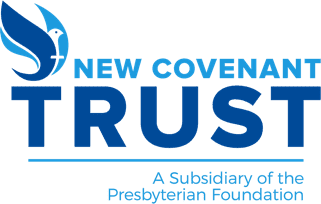
New Covenant Trust Company was proud to partner with the Presbyterian Investment & Loan Program and the Presbyterian Foundation on “Assets & Liabilities: Managing Your Church’s Balance Sheet,” a webinar that took a close look at strategies to help churches maximize their finances. This informative, interactive event covered everything from the key elements of a balance sheet to the “right” kind of debt to short- and long-term financial planning.
Below is a summary of the discussion. To view the full recording, click here.
The Balance Sheet: Overview
Robert Hay Jr., Senior Ministry Relations Officer with the Presbyterian Foundation, shared the key financial reports every church should have, including a profit and loss (P&L) statement, balance sheet and designated funds report. He went over a sample church balance sheet line by line, including different types of assets, liabilities, and designated funds (i.e., operating, unrestricted).
Hay shared the importance of educating Session members about the differences between the dollar amount in a church’s savings account vs. net assets on its balance sheet.
While many churches focus on cash, Hay noted there are two other asset classes that can be equally essential to a church’s bottom line but are sometimes ignored: investments and property.
“I often hear well-meaning church members say, ‘We can’t invest church money because that is being risky with money, and we have to be good stewards.’ I believe good stewardship means taking advantage of the different investment vehicles available, from money markets to CDs, to term notes, to bonds, stocks and equity, and finding a good and prudent approach that balances the appropriate level of risk with a maximum return for ministry,” Hay said.
Another common misconception is that church investment accounts must be treated like an endowment, he added. But investment accounts can be used for reserves that have no restrictions, or for designated funds.
Hay also advised that a church’s general operating fund should be “zeroed out” each year, with any surpluses or deficits moved to, or taken from, the reserve account. This allows the operating fund to start with a zero balance and reconcile with the budget for the next fiscal year.
In terms of property, Hays shared some tips on how to address fixed assets on the balance sheet, as well as mortgages and other debt related to church facilities on the liabilities side.
The Balance Sheet: Liabilities
Jim Rissler, President & CEO, and Clare Lewis, SVP of Sales and Marketing, with Presbyterian Investment & Loan Program, took a deep dive into the liability side of the balance sheet.
Rissler shared some factors to consider if a church is considering new debt, as well as steps to take when managing existing debt. For new projects, he advised choosing the “right type of debt.”
“You want to match the type of debt to the purpose of the loan,” he said. “If you’re doing a, a major renovation project or an expansion, or a large maintenance project like redoing the roof or HVAC system, then you want more of a traditional loan that’s got a long-term benefit.”
For smaller projects, a short-term loan or line of credit could be a better option. A line of credit could also serve as a bridge for churches with fluctuations in cash flow.
Rissler advised churches to plan for debt and carefully assess how much debt they can handle. He and Lewis shared the benefits and challenges of holding a capital campaign fund drive to finance major projects. Lewis also delved into strategies for managing existing debt, including refinancing and debt reduction campaigns.
The Balance Sheet: Assets
James Carey, Director of Investment & Portfolio Management Services with New Covenant Trust Company, discussed faithful stewardship of a church’s investments through careful asset allocation.
“Asset allocation is the mix between stocks, bonds, and cash on your balance sheet. That is what drives over 90% of your returns. It might be more exciting to talk about picking stocks and timing the market at dinner parties — but that really accounts for less than 10% of your long-term returns over time,” Carey said.
He added that the drivers of a church’s asset allocation are the answers to two questions: How soon do you need your money? And, what sort of objectives and goals do you have for your assets?
For immediate and shorter-term needs, assets may be allocated in cash, certificates of deposit, money markets or short-term bonds. There is some safety, liquidity and stable value in this approach, but there are a few risks as well, including inflation (which diminishes purchasing power), and credit risk.
For medium-term goals like an upcoming capital project, churches could introduce some equity exposure to their portfolios. This might include global stocks and stock mutual funds, bonds and bond mutual funds.
For future needs — five years or more — that’s when churches should look at investing through endowments, both restricted and unrestricted, and other long-term unrestricted savings. This requires further diversification and a more balanced approach.
“We don’t want to have just 10 stocks. We want to have thousands of stocks across sectors, across industries, across geographies to really be a balanced and diversified investor,” Carey said. “With this balanced growth allocation, you can expect growth that is greater than inflation growth that supports spending rate.”
Carey also advised churches to work with a financial advisor like New Covenant Trust Company to develop an Investment Policy Statement (IPS), and “remain disciplined in your investment plan through market volatility.”
More About Church Finances
The webinar concluded with a Q&A session, with insightful questions submitted by participants. The panelists answered questions about short-term and low-risk investments, trusts vs. endowments, the right time to set up an endowment, the benefits of taking out a loan to finance major property enhancements vs. using funds already on hand, and recommendations for reviewing and updating fixed assets on the balance sheet.
If you’re interested in learning more about how New Covenant Trust can partner with your church on financial planning and investment management, please don’t hesitate to contact us at 800-858-6127, Option 6.
